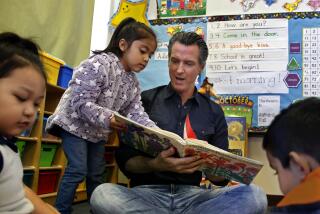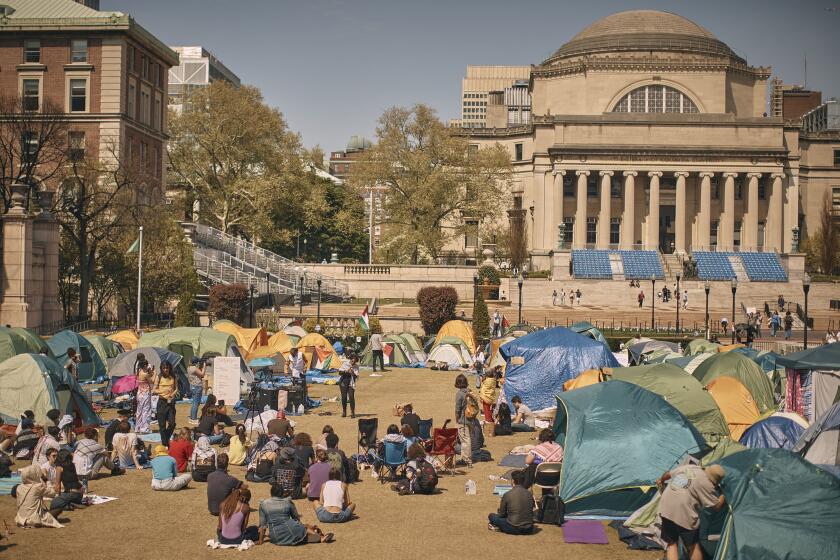Could Donald Trump’s education policy change schools in California and nationwide?
During his final debate against Hillary Clinton, Donald Trump bemoaned the state of America’s schools.
“Our inner cities are a disaster,” he said. “They have no education.”
It was a sweeping statement, unaccompanied by a solution.
But if the president-elect’s education plans haven’t been spelled out in detail, he has given some broad indications.
He has said he might eliminate or scale back the U.S. Department of Education. He wants to create a new school voucher program, support home-schooling, beef up childcare subsidies.
Educators across the country are waiting and wondering. Usually they know more by this point.
Traditionally, for example, both candidates appear before the American Federation of Teachers union to be considered for endorsement, said the union’s president, Randi Weingarten. Trump didn’t come — and the transition team has not returned her calls.
In the U.S., states and school districts control most education dollars and school-level decisions. Still, Trump has some power to act alone and with the help of Congress in ways that might affect California schools. For example, some expect Trump to give the state more breathing room in an ongoing fight over how schools should be rated. Other possible moves:
Michelle Rhee meets with Donald Trump. Could his education secretary be a Democrat? »
1) He could cut federal education funding.
The federal government funds a number of education programs. On average, these dollars made up about 8.7% of school districts’ budgets in the 2013-2014 school year, according to the National Center for Education Statistics. In California as well as for the Los Angeles Unified School District, they have a slightly bigger share: 11%.
Schools on Native American reservations and military bases don’t have local tax revenue bases, so they rely on federal money. These schools were hurt most by previous budget cuts.
Such schools in California include Sherman Indian High School in Riverside and Noli School in San Jacinto.
While Congress has to approve budgets, the president kicks off the process with his proposal for spending. “What he can do is cut the budget of education,” said California State Board of Education President Mike Kirst, who briefly worked in the Lyndon B. Johnson administration. “He seems to have other priorities, so education might be cut.”
2) Minority, disabled and transgender students, and students who are in the country without legal permission, could lose a layer of protection.
Some of Obama’s most controversial education policies have come out of the Justice Department’s Civil Rights Division and the Department of Education’s Office of Civil Rights.
In 2014, the two departments told school districts they could not discriminate against students based on immigration status. The office directed districts to establish families’ proof of residency without asking for citizenship papers.
In May, the Obama administration directed schools to let transgender students use bathrooms that match their gender identities. More than 10 states sued.
In July, the administration classified ADHD as a specific disability whose status shields students from discrimination.
But nothing enshrines these directives in law so they can be rescinded without congressional approval.
“I believe on day one, they’ll rescind all of these letters,” said Michael Petrilli, president of the Thomas B. Fordham Institute, a right-leaning think tank based in Washington, D.C.
How would this affect local schools? According to Judy Chiasson, Los Angeles Unified’s coordinator for Human Relations, Diversity & Equity, the school district and the state have particularly strong protections in place, including for transgender students.
“A state can give more protection [than is required], but not less,” Chiasson said of transgender students. “What happens at the federal level would not preclude a district...from being able” to protect students from discrimination.
3) He could take on fewer investigations into school districts’ wrongdoing or sexual assault on college campuses.
The Education Department’s Office of Civil Rights is tasked with investigating school districts and universities accused of violating students’ civil rights. The office has been the firepower behind the federal government’s war against rape on college campus. Last summer, San Bernardino County reached an agreement with the federal government after the office found it to be violating federal law in its treatment of students with disabilities.
Due to federal budget cuts, staffing has declined from about 1,200 in 1990 to 563 in 2016. At the same time, the number of complaints it receives has grown dramatically, particularly over the course of the Obama administration. In 2015, the office reached over 1,000 resolutions and opened more than 3,000 investigations.
Under President George W. Bush, the office still enforced civil rights law but was known for doing “desk audits” — checking websites and making calls primarily instead of conducting interviews in person, said Dianne Piche, a former OCR deputy assistant secretary.
Trump has called for shrinking the federal government, including the Education Department. “He can cut the office of Civil Rights,” Kirst said. “I see a lot less going on there.”
“It’s asking a leopard to shed its spots to expect this president to take a similar stand against words and actions he’s characterized as no more than locker room prattle,” said Mark Rosenbaum, a Los Angeles-based civil rights attorney at Public Counsel.
You can reach Joy Resmovits on Twitter @Joy_Resmovits and by email at Joy.Resmovits@LATimes.com.
ALSO
Michelle Rhee meets with Donald Trump. Could his education secretary be a Democrat?
More to Read
Start your day right
Sign up for Essential California for news, features and recommendations from the L.A. Times and beyond in your inbox six days a week.
You may occasionally receive promotional content from the Los Angeles Times.







